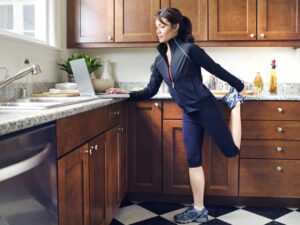In the exercise world, people often get mobility wrong. A lot of people think that being able to touch their toes or do a split is enough to be flexible. Flexibility is important, but movement is much more important for health and success as a whole. In this case, range of motion means that a joint can move through a certain range of motion with strength and control. Moving around easily, without pain, and strongly in daily life is what it means to have good movement. You can’t just stretch your way to strength; you have to teach your body how to move the way it was meant to. Anyone can improve their balance, lessen pain, and make their bodies stronger by doing routine movement exercises.
Why getting around is more important than you think
Stiffness and restricted range of motion can be caused by not moving around much, spending too much time in front of a screen, and doing the same things over and over. When joints don’t move properly, the body tries to make up for it in bad ways, which can cause pain, damage, or discomfort. When you can’t move around easily, even simple things like bending, reaching high, or turning your back become harder and more tiring. It also makes you less good at physical tasks like running, pulling weights, or even just playing with your kids. Focusing on movement not only makes you less stiff, but it also makes your power, agility, and balance better. This means that movement work is not only helpful, it’s also required for your health and freedom in the long run.
How Mobility Is Not the Same as Flexibility and Stretchin
Flexibility is the muscle’s ability to get longer, while mobility is the controlled moving through a joint’s full range of motion. Being open does not mean you have to be mobile. Someone may be able to gently pull their leg behind their head, but they don’t have movement if they can’t lift it there on their own or with help. Stretching, especially static stretching, can only make you more flexible to a certain point. Mobility routines, on the other hand, work muscles in an active way to improve function, fix weaknesses, and get the body ready to move. Because of this active control, movement is a key part of being strong and athletic generally.
How to Tell If You Need More Work on Your Mobility
You may need to work on your movement if you wake up stiff in the morning, can’t touch your toes, or find it hard to fully squat or lift your arms high. Cracking joints, tightness in the hips or shoulders that won’t go away, and pain during everyday movements are all signs of limited motion. A lot of people don’t pay attention to these signs and instead focus on working out more or lifting bigger weights, which can make things worse. Taking care of movement problems early on not only makes your life better, but it also keeps you from getting long-term joint problems and accidents that are caused by overuse.
Moving around every day in ways that make you more mobile
Getting up and moving around more during the day is one of the best ways to improve your movement. One of the main causes of joint pain is sitting for long periods of time. You can fight the effects of not being active by getting up and moving around a lot, taking breaks to move, and adding easy stretches and twists to your routine. When you take short breaks from work, do hip circles, shoulder rolls, and spine twists. This will keep your joints moist and your body feeling less tight. You can stay flexible at work without spending extra time if you use standing desks, active sitting tools, or walking meetings.
Exercises for mobility that really work
It’s important to do workouts that move your joints through their full lengths while also making them more stable and controlled. Deep bodyweight squats, hip openers, arm circles, and thoracic spine rotations are all exercises that work out a lot of muscles and train your joints to move better. Self-myofascial release and foam rolling can also help these workouts by easing tightness and bringing more blood to areas that feel tight. Controlled Articular Rotations (CARs), for instance, work on specific joints like the shoulders or hips and teach the brain how to keep power at the end of a range of motion. Over time, these activities not only make it easier to move around, but they also make you less likely to get hurt.
Making flexibility a regular part of your workout plan
Consistency is the key to building long-term movement. For movement work to work, you have to do it regularly, just like power training or exercise. It doesn’t need to take a lot of time. If you do it on purpose, even 10 to 15 minutes a day can make a big difference. When should you do movement exercises? In the morning to loosen up after a night’s sleep, before a workout as part of a warm-up, or at night to relax and calm. When you do these little things every day, they will help your body stay in good shape for years to come.
How mobility training can help with pain and keep you from getting hurt
One of the best ways to avoid injuries, especially ones that are caused by abuse or bad movement habits, is to do mobility training. When muscles or joints are tight, the body has to make up for it by putting stress on other parts of the body, which can cause pain or problems. Back pain can be caused by hips that don’t move properly. Knee pain can be caused by ankles that don’t move enough. You can get your body back to its natural physics by improving your movement. This lets your body absorb force and move more effectively. This makes your body stronger against stress, both during workouts and in everyday life. For this reason, a lot of physical therapists use movement training as an important part of recovery.
Getting stronger by moving around
People often think that movement is only for people who like to stretch or do yoga, but it actually builds power in a very useful way. You get more control and power throughout your movement when you work out muscles at the end of their range of motion. This means better success for sports. It means being able to lift things, go up and down stairs, or get up from the floor more easily for most people. You can test your balance and get stronger by doing mobility tasks with resistance bands, your own body weight, or light weights. While in these longer areas, being bigger makes you safer and more powerful.
Mobility for People of All Ages and Ways of Life
You don’t have to be young or strong to be mobile. At any age, it’s important. We lose our movement naturally as we age if we don’t do anything to keep it up. This makes it more likely to fall, makes you stiff, and limits your freedom. Kids who are mobile grow up healthy and are less likely to have joint problems as they get older. It helps office workers and older people keep their balance, avoid pain, and keep up with daily tasks. Mobility training that is based on your skills and goals can help everyone. Adding it to your routine early on will make it easier to stay busy and pain-free as you age.
A Long-Term Plan to Go From Stiff to Strong
It takes time to get better at moving around; it’s not a quick fix. You need to be patient, consistent, and know what your body needs. From stiff to strong is a trip that starts with small habits that you do every day and turns into a way of life that you can keep up. When you make motion a part of your exercise routine, every other move you do gets easier, more comfortable, and more effective. It’s very helpful to have strong, flexible joints whether you’re pulling weights, doing yoga, or just going about your day.




